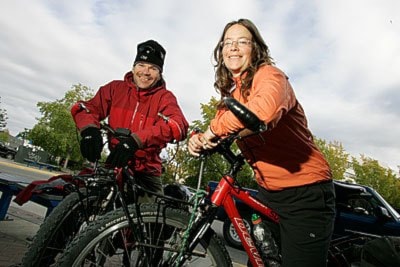It takes an extreme case of wanderlust to have spent the past 12 years with one’s bottom wedged to a bike seat, pedaling 175,000 kilometres across some 50 countries while hauling 40 kilograms of gear.
Even more strange is to have achieved this feat, not in the name of any cause célèbre, such as climate change, but in the pursuit of spotting volcanoes.
Strange, but true, are the lives of Janick Lemieux, 36, and Pierre Bouchard, 42.
Last week the couple, who hail from Charlesvoix, Quebec, visited Whitehorse — which may seem an unlikely destination for volcano enthusiasts.
But, in fact, there are several prominent volcanic sites in the region. And it’s en route to nearby Alaska, the home of some active volcanoes.
The decision to dedicate several years of their lives to spotting volcanoes was made inside a tent one December night in 1997, on an icy plateau in Tibet.
It was minus 20 C. They were in the middle of another biking expedition, which would take them in three months from Magadan, Siberia, to Calcutta, India.
They looked at their biking shoes, once wet, now frozen, and thought about how nice it would be to go someplace warm.
They decided their next biking expedition would be a tour of the Ring of Fire — a 40,000-kilometre horseshoe that encompasses three quarters of the world’s active and dormant volcanoes.
They broke the trip into three legs. First: in May 1999 they biked from Vancouver to Santiago, Chile, traveling 25,000 kilometres over 25 months.
Next: returning to San Diego in November 2002, they made their way to Jakarta, Indonesia, and proceeded to pedal across 30 islands in the South Pacific.
To do so required taking 55 boat rides and 12 flights. They travelled about 11,000 kilometres in 18 months.
A book, in French, is in the works. They are calling that chapter of their journey “the ordeal.”
Last: Vancouver to Alaska — which is brought the couple through Whitehorse.
While approaching Whitehorse they diverted to visit Atlin in northern BC, home of the volcanic Ruby Mountain.
The Klondike Nugget reported on January 28, 1899, that the mountain belched fire and ash for several days, and that “the miners were working nights, gladly profiting by the mellowing twilight caused by the volcano’s glare, which turned night into day.”
This story may be too good to be true. Later studies have disputed whether any eruption occurred that recently.
The miners may merely have seen sunlight glinting off the mountain’s volcanic, ruby-coloured rock, after which the mountain is named, says Charles Roots with the Geological Survey of Canada in Whitehorse.
Regardless, Ruby Mountain and the prominent lava flows that surround it remain one of the more popular volcanic sites in the region.
Volcanoes helped shape the Yukon.
Nearby Mt. Churchill of Alaska, for example, is a big reason why the White River is white.
When Mt. Churchill exploded 2,000 years ago, the wind blew eastwards, blanketing 340,000 kilometres of what today is the Yukon with white ash.
That ash can still be seen on sections of the Alaska Highway, where cutaways of the soil reveal a ribbon of white ash up to 60 centimetres thick.
The same ash mixed with the White River’s glacial headwaters, helping give the river its name, says Roots.
Such connections between the distant past and the scenery whirring past on a bicycle are, the cyclists say, what keeps them engaged.
“This is what makes the world. It makes you aware of the planet. This creates the
world you are rolling on,” says Bouchard.
Whitehorse is home to two volcanoes. They are a 20-minute helicopter ride away from the city, found just north of Alligator Lake, not far from the Mt. Sima ski area.
There, protected by heavy bush, are two cinder cones — the conical shapes we think of as volcanoes — older than the last ice age.
They last erupted between nine to 15 million years ago, producing a river of lava that flowed to the Yukon River valley, where it cooled to form columns of rock up to 15 metres thick, known as the Miles Canyon basalts.
Further afield is another well-known volcanic attraction, known, predictably enough, as Volcano Mountain.
Each year visitors travel up the Klondike Highway, to Pelly Crossing, where they spend a day hiking to the volcano (which is now dotted with spruce trees) that rises 540 metres above the swampy valley below.
The volcano, older than 7,300 years, is rough hiking terrain. Lemieux and Bouchard didn’t make the trip, but Roots has.
He describes lava formations that include “spine-like things that stick up six to eight feet, bits of globby lava that were starting to get stiff when the lava was still moving.”
“Unless you go to Hawaii and look at ones that came out 20,000 years ago, these are about as good as they get, as real lava flow,” Roots says.
No volcano in the Yukon has erupted in recent memory. But just this July, one of the Aleutian islands — all volcanic — erupted, blowing hot ash more than 15,000 metres above sea level, and sending scientists scurrying for safe ground.
Such an eruption will happen at some point in the Yukon. But the odds of this occurring within our lifetimes, says Roots, is so slim as to be negligible.
“There’s almost no chance,” he says.
